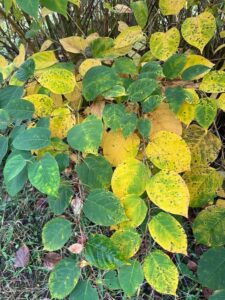
Up and down the UK, leaves are currently turning yellow on many plants and trees, and it is particularly striking the on the Japanese knotweed stands. In the autumn, as part of the natural process of senescence, which is the aging and eventual shedding of leaves, this process is primarily triggered by changes in the environment, especially the decreasing amount of daylight and cooler temperatures that occur in Autumn months. The relationship between the position of the sun and the yellowing of leaves is mainly due to the “photoperiod”, or the length of daylight.
Here’s how it works:
- Decreasing Daylight: As summer transitions into autumn, the days gradually become shorter. With less sunlight available, it triggers the release of hormones like abscisic acid in the leaves, which signal the plant to prepare for winter and initiate the process of leaf senescence.
- Chlorophyll Breakdown: Chlorophyll is the green pigment in leaves that is crucial for photosynthesis, the process by which plants convert sunlight into energy. As the days grow shorter and cooler, the tree begins to reabsorb nutrients and chlorophyll from the leaves. Chlorophyll is broken down and not replenished, causing the green colour of the leaves to fade and reveal the underlying yellow and orange pigments.
- Carotenoids: Yellow and orange pigments in leaves, known as carotenoids, are always present but are masked by the dominant green of chlorophyll during the growing season. When the chlorophyll breaks down and disappears, the carotenoids become more visible, resulting in the yellow and orange colours that we associate with autumn leaves.
- Sun Angle and Intensity: The position of the sun also plays a role in the timing and intensity of the colour change. In the autumn, the sun’s angle in the sky decreases, and the sunlight becomes less intense. This change in sunlight conditions can influence the rate at which the leaves senesce and the specific colours that develop. Trees and plants at higher latitudes may experience more vibrant autumnal colours due to the steeper angle of the sun’s rays.
In summary, leaves turn yellow in the autumn because of the decreasing daylight hours, which triggers a series of physiological changes in the trees and plants. These changes lead to the breakdown of chlorophyll and the emergence of yellow and orange pigments. The position of the sun influences the timing and intensity of the colour change, as the changing angle of the sun’s rays corresponds with the onset of Autumn and the transition into the winter season.
